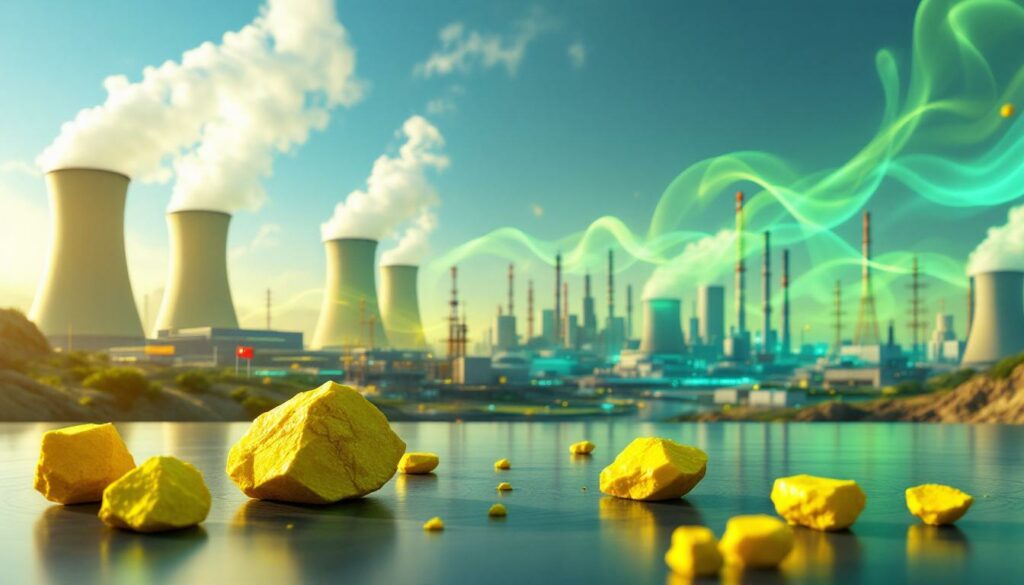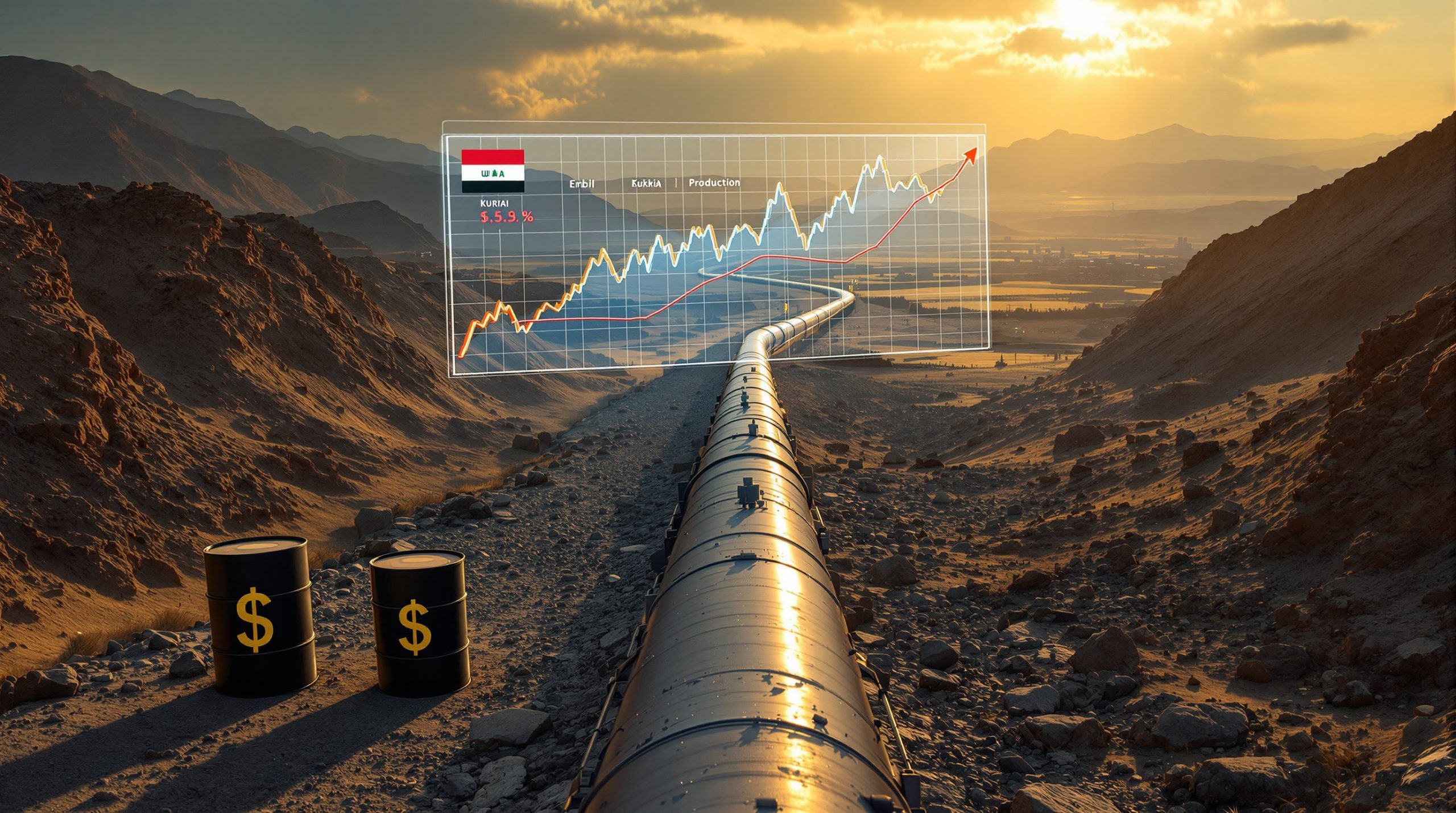How Does the Uranium Market Connect to Nuclear Energy?
The uranium market and nuclear energy sector are experiencing a significant transformation characterized by changing supply-demand dynamics, evolving regulatory frameworks, and growing recognition of nuclear power's role in clean energy transitions. This complex market operates with unique characteristics that differentiate it from other commodity markets.
The Fundamental Connection Between Uranium and Nuclear Power
Nuclear energy production relies entirely on uranium as its primary fuel source. The nuclear fuel cycle begins with uranium mining and progresses through several processing stages before becoming usable fuel for nuclear reactors. This interdependence creates a specialized market where utility companies must secure long-term fuel supplies to ensure operational continuity.
The fuel cycle transforms raw uranium ore into the highly engineered fuel assemblies that power the world's 440+ operating nuclear reactors, highlighting the inseparable relationship between uranium mining and nuclear electricity generation.
Current Market Structure and Pricing Mechanisms
The uranium market operates through two primary channels:
- Spot Market: For immediate delivery transactions, currently trading around $75-80 per pound
- Term Market: For long-term contracts, currently trading around $80-90 per pound
Unlike many commodity markets, uranium trading involves relatively small volumes with specialized participants, making it susceptible to significant uranium market volatility from relatively modest changes in buying patterns. The spread between spot and term prices offers valuable insights into market expectations and supply-demand balance.
What's Driving the Current Uranium Supply-Demand Imbalance?
The uranium market and nuclear energy sector is experiencing a structural supply deficit that appears to be intensifying, creating potential challenges for nuclear operators and opportunities for investors.
Current Supply Deficit Analysis
According to industry models, 2025 will see approximately:
- 200 million pounds of global uranium demand from nuclear reactors
- 160-165 million pounds of primary mine production
- 35 million pound structural deficit before accounting for secondary supplies
This deficit is partially offset by secondary supplies, including:
- Enrichment underfeeding (reduced to approximately one-third of levels from three years ago)
- Inventory drawdowns (significantly diminished compared to previous years)
- Limited government stockpile releases
The persistent gap between production and consumption highlights the fundamental imbalance that underpins current market dynamics and price movements.
Secondary Demand Factors Amplifying Market Pressure
Beyond primary reactor demand, several secondary demand factors are intensifying market pressure:
- Financial players: Entities like Sprott Physical Uranium Trust purchasing physical uranium
- Inventory restocking: Utilities buying beyond immediate needs to rebuild depleted stockpiles
- Military requirements: Countries like China expanding military stockpiles, with the US potentially following suit
These additional demand sources compete for the same limited uranium supply, further straining an already tight market and potentially accelerating price discovery.
Supply Response Challenges
The market is witnessing a supply response, but it faces significant hurdles:
- Brownfield restarts experiencing delays: Most reactivated mines facing production challenges
- Greenfield development timelines extending: Major new projects like Arrow pushing first production dates further out
- Legacy mine depletion: Key producing assets like Rössing, Cigar Lake, and Husab approaching end-of-life within the next 5-15 years
- Permitting and financing hurdles: Regulatory processes extending development timelines
These challenges indicate that even with higher prices, meaningful supply increases will take years to materialize, suggesting the current deficit could persist or even worsen before improving.
How Has Nuclear Energy's Public Perception Evolved?
Nuclear energy's public perception and regulatory environment have undergone significant transformation in recent years, creating a more supportive backdrop for industry growth.
Major Policy Shifts Supporting Nuclear Development
Recent policy developments signal growing institutional support for nuclear energy:
- World Bank policy reversal: After decades of not financing nuclear projects (since the 1950s), the World Bank has lifted restrictions on nuclear energy project financing
- EU taxonomy inclusion: Germany's acceptance of nuclear as "green" despite its domestic phase-out
- UK funding commitments: Approval of approximately £14 billion for the Sizewell C nuclear project
- US incentive programs: Federal initiatives to support domestic uranium production and nuclear development
These policy shifts reflect a growing recognition of nuclear energy's essential role in achieving carbon reduction goals while providing reliable baseload power generation.
Global Nuclear Expansion Momentum
Nuclear energy is experiencing significant growth globally:
- China's accelerated buildout: Approving approximately 10 new reactors annually and on track to reach 150 GW capacity by 2035
- Small Modular Reactor (SMR) pipeline expansion: Global SMR development pipeline doubling in the past 12 months to over 50 GW
- Technology sector involvement: Major tech companies investing in nuclear projects (e.g., Nvidia's venture capital arm investing $650 million in TerraPower)
- 3.1% compound annual growth rate in global nuclear capacity based on current construction and operating reactors
This growth trajectory represents a marked departure from the post-Fukushima era of uncertainty and highlights nuclear energy's resurgence as a key component of global energy strategies.
What Are the Key Uranium Market Developments to Watch?
Several recent developments signal potential acceleration in uranium market dynamics that could impact both prices and industry structure.
Sprott Physical Uranium Trust's Market Impact
The Sprott Physical Uranium Trust (SPUT) has emerged as a significant market force:
- $200 million bought deal: Recently closed a major capital raise through Canacord Genuity
- Physical uranium purchasing program: Poised to deploy significant capital into uranium purchases
- Potential market price impact: Traders already pushing prices up $5 in anticipation of SPUT buying activity
- Precedent-setting transaction: Establishes a model for financial players to influence physical uranium markets
As a financial entity with a mandate to buy and hold physical uranium, SPUT has demonstrated its ability to move prices in what remains a relatively thin market, creating both opportunities and challenges for market participants.
Uranium Price Sensitivity Factors
The uranium market demonstrates unique price sensitivity characteristics:
- Limited inventory buffer: Historical inventory overhang has largely dissipated
- Constrained secondary supplies: Reduced availability of non-production sources
- Financial buying influence: Relatively small capital deployments can move prices significantly
- Utility procurement patterns: Shifting from opportunistic to strategic buying as uncovered positions grow
These factors contribute to a market environment where relatively modest changes in buying behavior can trigger outsized price movements, creating potential volatility but also trading opportunities.
Future Production Uncertainty
The uranium market faces significant uncertainty regarding future production sources:
- Project development timelines extending: Major projects like NexGen's Arrow now targeting first production no earlier than 2031
- Incentive price requirements: Many marginal projects requiring sustained uranium prices above $100/lb to proceed
- Utility contracting requirements: Developers needing long-term utility contracts at acceptable terms before committing capital
- Cumulative supply deficit: Industry models projecting a 400 million pound cumulative supply deficit over the next decade
This production uncertainty underscores the challenges in addressing the current supply-demand imbalance and suggests potential for sustained higher prices to incentivize necessary development.
How Does the Uranium Fuel Cycle Work?
Understanding the uranium fuel cycle provides crucial context for market dynamics and the specialized nature of this commodity.
Mining and Initial Processing
The uranium production process begins with extraction and initial processing:
- Mining methods: Including conventional underground/open-pit mining and in-situ recovery (ISR)
- Yellow cake production: Processing ore into uranium trioxide (U₃O₈), a mildly radioactive yellow powder
- Conversion: Transforming yellow cake into uranium hexafluoride (UF₆) for enrichment
Each stage requires specialized facilities and expertise, creating potential bottlenecks in the supply chain and contributing to the market's unique characteristics compared to other commodities. For a deeper understanding of modern extraction methods, US ISR production insights reveal how these technologies are being deployed domestically.
Enrichment Process and Requirements
Natural uranium requires enrichment for most commercial reactors:
- Natural uranium composition: Contains approximately 0.7% uranium-235 (U-235), the fissile isotope
- Light water reactor requirements: Most commercial reactors require 4-5% U-235 enrichment
- Enrichment process: Using centrifuges to separate isotopes based on slight mass differences
- High-assay low-enriched uranium (HALEU): Advanced reactor designs requiring up to 19.9% enrichment
- Weapons-grade uranium: Military applications requiring over 90% enrichment through extended processing
This technical distinction between commercial and military enrichment levels illustrates the separation between civilian nuclear power and weapons applications, despite both utilizing uranium as a base material.
Fuel Fabrication and Reactor Use
The final stages of the fuel cycle involve:
- Fuel rod fabrication: Converting enriched uranium into fuel assemblies
- Reactor operation: Using controlled fission reactions to generate heat and electricity
- Spent fuel management: Storing and potentially reprocessing used fuel
- Plutonium production: Reactor operation creating plutonium as a byproduct, which requires specialized extraction for weapons use
Understanding these technical aspects of the fuel cycle helps explain the specialized nature of the uranium market and the multiple factors that influence supply, demand, and pricing across the nuclear value chain.
What Investment Considerations Apply to the Uranium Market?
The uranium market presents unique investment characteristics that differentiate it from other commodity markets.
Market Volatility Patterns
Uranium equities demonstrate distinctive volatility patterns:
- Extended bullish trends: The Uranium ETF (URA) recently recorded 10 consecutive weeks of gains
- Sharp sentiment swings: Dramatic shifts from extreme pessimism to bullishness over short periods
- Disconnection from fundamentals: Price movements sometimes detached from underlying market conditions
- Exogenous event sensitivity: Heightened reaction to geopolitical developments and regulatory changes
These volatility patterns create both risks and opportunities for investors, requiring careful timing and risk management strategies to navigate successfully. The U.S. market disruptions demonstrate how policy decisions can create sudden shifts in market conditions.
Structural Bull Market Characteristics
The current uranium market differs fundamentally from previous cycles:
- Sustained supply deficit: Unlike previous cycles with inventory overhang and secondary supplies
- Actual vs. planned nuclear growth: China and others executing on planned nuclear expansion rather than just announcing intentions
- Limited inventory buffer: Historically low inventory levels across the fuel cycle
- Growing recognition of nuclear's role: Broader acceptance of nuclear in clean energy transition
These structural characteristics suggest the potential for a more sustained bull market compared to previous cycles, with potentially higher price targets and longer duration.
Investment Timing Considerations
Effective uranium market investment requires understanding cyclical patterns:
- Buyable dips in structural bull markets: Market corrections presenting potential entry points
- Physical market signals: Changes in spot market trading patterns and carry trade volumes providing early indicators
- Utility procurement cycles: Awareness of utility buying patterns and uncovered positions
- Project development timelines: Realistic assessment of when new supply might enter the market
By monitoring these timing considerations, investors can potentially identify favorable entry and exit points in what remains a cyclical, albeit structurally supported, commodity market.
What Are the Risks to the Uranium Market Thesis?
While the uranium market demonstrates strong structural support, several risk factors could impact market development.
Geopolitical and Military Risks
Nuclear weapons concerns create unique market considerations:
- Nuclear conflict scenarios: Limited direct correlation between nuclear weapons use and commercial uranium markets
- Enrichment facility targeting: Military strikes on enrichment facilities (as seen with Israel-Iran tensions) having minimal impact on commercial markets
- Public perception impacts: Potential negative sentiment spillover from military nuclear applications to civilian nuclear power
These geopolitical factors require careful monitoring, particularly as nuclear proliferation concerns remain present in several regions globally. Furthermore, the US uranium import ban on Russian material demonstrates how geopolitical tensions can reshape supply chains.
Supply-Side Surprises
Several factors could potentially disrupt supply expectations:
- Technological breakthroughs: Potential developments like seawater uranium extraction (being researched by China)
- Accelerated project development: Faster-than-expected permitting or construction of major projects
- Secondary supply increases: Unexpected inventory releases or enrichment underfeeding increases
- Production outperformance: Existing mines exceeding production targets
While current evidence suggests limited risk of near-term supply surprises, these potential developments could alter market dynamics over the medium to long term.
Demand-Side Risks
Potential factors that could impact uranium demand include:
- Nuclear accidents: Safety incidents potentially affecting public perception and policy
- Policy reversals: Countries abandoning nuclear expansion plans or accelerating phase-outs
- Technological competition: Breakthrough developments in alternative energy storage or generation
- Economic downturns: Reduced electricity demand affecting nuclear plant economics
Despite the current positive momentum for nuclear energy, these risk factors highlight the importance of maintaining a balanced assessment of potential market trajectories.
How Does Uranium Market Sentiment Impact Investment Opportunities?
Market sentiment plays a crucial role in uranium market dynamics, creating both challenges and opportunities for investors.
Sentiment Cycle Characteristics
The uranium market demonstrates distinctive sentiment patterns:
- Extreme pessimism at bottoms: Social media negativity and capitulation often marking market lows
- Rapid sentiment shifts: Quick transitions from bearish to bullish narratives
- Narrative-driven trading: Market movements influenced by evolving stories about supply-demand balance
- Technical factor influence: RSI readings reaching extreme levels (e.g., 18 in April) during sentiment troughs
Understanding these sentiment cycles can help investors identify potential turning points and avoid being caught in emotionally-driven trading decisions.
Contrarian Indicators
Several contrarian signals have historically provided valuable market timing insights:
- Social media negativity: Extreme negative sentiment on platforms like Twitter/X often preceding market turns
- Analyst capitulation: Mainstream analysts abandoning bullish theses near market bottoms
- Short-selling narratives: Hedge funds promoting bearish theses based on limited due diligence
- Physical market disconnects: Spot price weakness despite improving physical market fundamentals
These contrarian indicators can serve as valuable tools for identifying potential market inflection points, particularly when combined with fundamental analysis.
Long-Term vs. Short-Term Perspectives
Successful uranium market navigation requires balancing timeframes:
- Short-term overbought conditions: Technical indicators suggesting potential consolidation after extended rallies
- Long-term structural support: Fundamental supply-demand imbalance providing underlying support
- Utility procurement cycles: Understanding the timing of utility buying patterns and budget cycles
- Development pipeline realities: Recognizing the extended timelines required for meaningful supply additions
This balance between short-term trading considerations and long-term structural factors helps investors maintain perspective during periods of market volatility and avoid missing broader trends due to short-term noise.
FAQ: Common Questions About Uranium and Nuclear Energy
Is there a connection between nuclear weapons and commercial nuclear power?
While both nuclear weapons and commercial nuclear power utilize uranium, they represent distinct applications with different requirements. Commercial reactors typically use uranium enriched to 4-5% U-235, while weapons require over 90% enrichment. The recent tensions between Israel and Iran involving attacks on enrichment facilities have had minimal impact on commercial uranium markets, demonstrating the separation between these sectors.
How long does it take to develop a new uranium mine?
Developing a new uranium mine is a lengthy process. Major projects like NexGen's Arrow, even with favorable permitting outcomes, are targeting first production no earlier than 2031. This timeline includes approximately 48 months of construction after permitting is complete. Most greenfield uranium projects face similar extended timelines, contributing to the projected supply deficit in the coming decade.
What role do financial players like Sprott Physical Uranium Trust play in the market?
Financial entities like the Sprott Physical Uranium Trust (SPUT) have emerged as significant market participants. SPUT's mandate is to buy and hold physical uranium, providing investors with exposure to the commodity. Their recent $200 million capital raise signals potential for substantial uranium purchases that could influence market prices. These financial players can accelerate price movements in what is a relatively small commodity market.
How do uranium contract prices differ from spot prices?
The uranium market operates with two primary pricing mechanisms. The spot market (currently around $75-80/lb) represents immediate delivery transactions and tends to be more volatile. The term market (currently around $80-90/lb) reflects long-term contract prices that utilities pay for future deliveries. Most uranium is traded through term contracts, though spot prices often receive more attention. The spread between these prices provides insights into market expectations.
What makes the current uranium bull market different from previous cycles?
The current uranium market differs fundamentally from previous cycles in several ways. Unlike the 2004-2007 bull market, today's market features a structural supply deficit, actual rather than just planned nuclear growth (particularly in China), limited inventory buffers, and growing recognition of nuclear's role in clean energy transitions. These factors suggest a more sustainable bull market with potentially higher price targets than previous cycles.
Ready to Stay Ahead of the Next Major Uranium Discovery?
Gain instant alerts on significant ASX uranium discoveries with Discovery Alert's proprietary Discovery IQ model, turning complex mineral data into actionable insights. Understand why historic discoveries can generate substantial returns by visiting Discovery Alert's dedicated discoveries page and begin your 30-day free trial today to position yourself ahead of the market.




